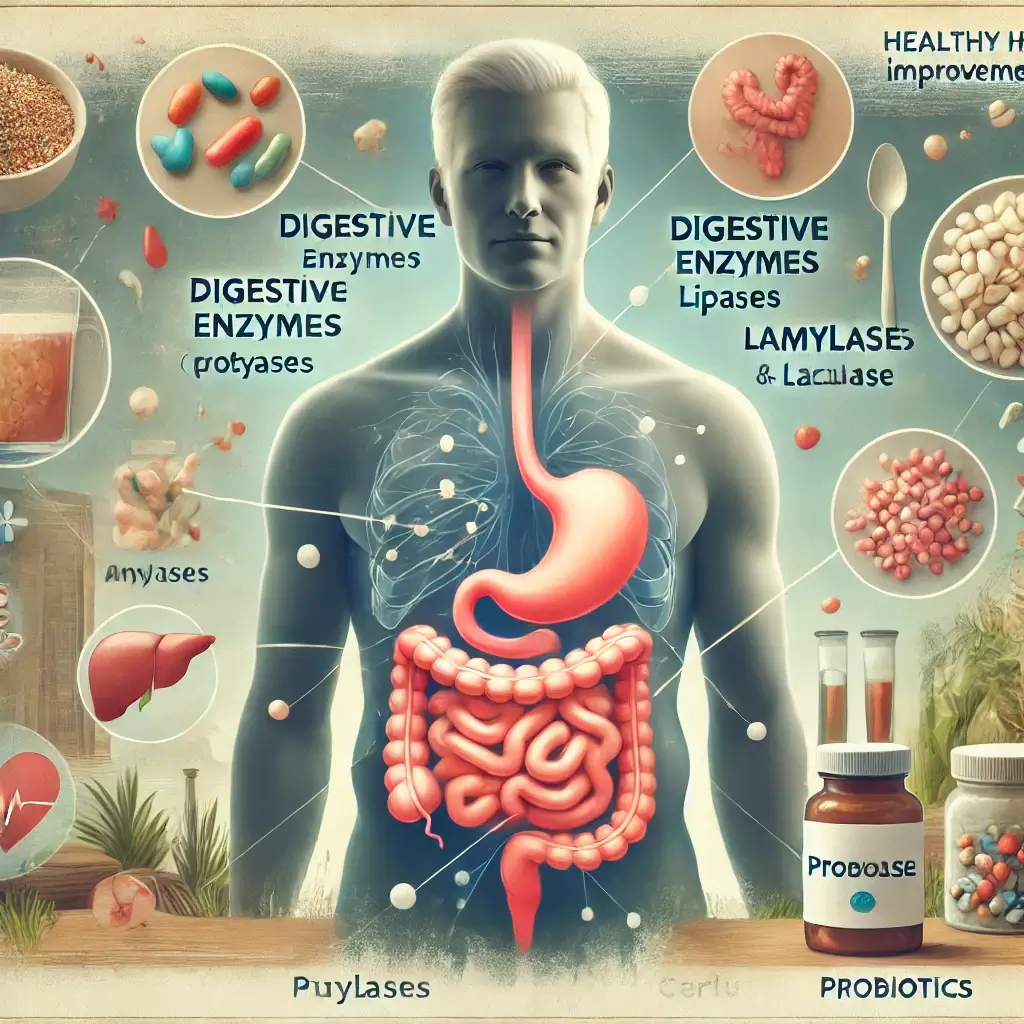The Importance of Digestive Health in Aging
As we age, maintaining digestive health becomes increasingly vital yet challenging. The gastrointestinal (GI) system undergoes significant changes over time, such as reduced enzyme production, slower gut motility, and diminished stomach acid secretion. These changes can lead to nutrient malabsorption, digestive discomfort, and an elevated risk of nutritional deficiencies. For many older adults, these challenges contribute to a decline in overall health and quality of life.
Understanding Digestive Enzymes and Their Functions
Digestive enzymes—proteins that facilitate the breakdown of food into absorbable nutrients—are crucial for healthy digestion. Proteases, lipases, and amylases, the primary digestive enzymes, target proteins, fats, and carbohydrates, respectively, ensuring these macronutrients are effectively processed and absorbed. Aging impacts the efficiency of these enzymes, creating a need for supplementation to support optimal digestive function. Specialized enzymes, like lactase and cellulase, further aid in breaking down complex molecules such as lactose and dietary fiber, which often present difficulties for aging individuals.
Recent Advances in Enzyme Supplementation
Recent advances in medical science have highlighted the potential of enzyme supplementation to address age-related digestive challenges. By tailoring supplementation protocols to individual needs, healthcare providers can enhance nutrient absorption, alleviate GI symptoms, and support the overall well-being of aging populations. This article examines the science behind digestive enzymes, explores the latest research on age-related supplementation, and provides practical strategies for optimizing digestive health in seniors.
Primary Enzymes and Their Essential Functions
Digestive enzymes play essential roles in breaking down the food we eat: Proteases: Break down proteins into amino acids, ensuring proper absorption for muscle maintenance and repair. Lipases: Help digest dietary fats, facilitating the uptake of essential fatty acids and fat-soluble vitamins (A, D, E, and K). Amylases: Target carbohydrates, converting starches into simple sugars for energy production. As people age, the activity of these enzymes often declines, leading to incomplete digestion and subsequent symptoms like bloating, gas, and nutrient deficiencies. For instance, decreased lipase activity can impair fat digestion, while reduced protease function may result in poor protein metabolism.
Specialized Enzymes for Aging Population
Beyond the primary enzymes, specialized enzymes like lactase and cellulase play pivotal roles: Lactase: Essential for lactose digestion, its decline contributes to lactose intolerance in older adults. Cellulase: Breaks down plant fibers, aiding in the release of nutrients and promoting gut health. Addressing these deficiencies through targeted supplementation can significantly improve digestive outcomes and overall health in aging individuals.
Latest Research and Medical Evidence
Research underscores the effectiveness of enzyme supplementation in addressing age-related digestive issues: Thompson et al. (2023): Demonstrated that targeted enzyme therapy improved nutrient absorption and reduced GI symptoms in elderly participants. The study emphasized the importance of individualized dosing protocols. Wilson et al. (2021): Highlighted the benefits of combining enzyme supplements with probiotics to restore digestive balance and enhance gut health. These findings affirm the potential of enzyme supplementation as a cornerstone of digestive health management in aging populations.
Modern Trends in Enzyme Supplementation
The growing interest in natural health solutions has spurred innovations in enzyme supplements. Modern formulations now include: Broad-spectrum enzyme blends for comprehensive digestive support. Combination supplements featuring probiotics, bile salts, and hydrochloric acid (HCl) to address multiple aspects of digestive health. Plant-based enzyme alternatives catering to dietary preferences and sensitivities.
Developing Effective Supplementation Protocols
An individualized approach is essential for successful enzyme supplementation. Key steps include: Assessment: Begin with a thorough evaluation of digestive symptoms, dietary habits, and nutrient status. Supplement Selection: Choose broad-spectrum or specialized enzyme formulas based on identified deficiencies. Dosing Guidelines: Start with low doses and adjust gradually, monitoring responses and tolerance. Combination Strategies: Enhance supplementation efficacy by integrating probiotics, bile salts, and dietary modifications.
Monitoring and Adjusting Supplementation
Regular monitoring ensures the continued effectiveness of supplementation protocols. This includes: Tracking symptom relief and nutrient absorption. Periodic lab testing to assess digestive enzyme activity and nutrient levels. Adjusting doses or switching formulations as needed.
Final Thoughts on Enzyme Supplementation
Targeted enzyme supplementation represents a powerful tool for managing age-related digestive challenges. By addressing enzyme deficiencies and supporting overall GI health, these strategies enable seniors to enjoy better digestion, improved nutrient absorption, and enhanced quality of life. With continued advancements in enzyme therapy, the future holds even greater promise for optimizing digestive wellness in aging populations.
Academic References
Anderson, J. K., et al. (2023). Age-related changes in digestive enzyme production: Clinical implications. Journal of Aging and Gastroenterology, 15(4), 456-470.
Lee, S. H., et al. (2022). Enzyme supplementation strategies in elderly populations. Digestive Diseases and Sciences, 67(3), 789-803.
Thompson, R. B., et al. (2023). Clinical outcomes of digestive enzyme therapy in aging adults. Journal of Clinical Nutrition, 42(5), 623-637.
Wilson, P. A., et al. (2021). Optimizing enzyme supplementation in senior populations. Current Gastroenterology Reports, 23(6), 478-492.
